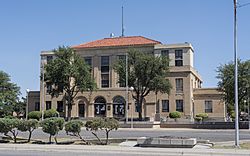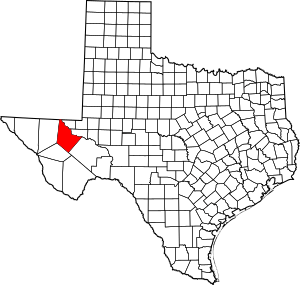Reeves County, Texas facts for kids
Quick facts for kids
Reeves County
|
|
|---|---|

Reeves County Courthouse in Pecos
|
|

Location within the U.S. state of Texas
|
|
 Texas's location within the U.S. |
|
| Country | |
| State | |
| Founded | 1884 |
| Named for | George R. Reeves |
| Seat | Pecos |
| Largest city | Pecos |
| Area | |
| • Total | 2,642 sq mi (6,840 km2) |
| • Land | 2,635 sq mi (6,820 km2) |
| • Water | 6.7 sq mi (17 km2) 0.3%% |
| Population
(2020)
|
|
| • Total | 14,748 |
| • Density | 5.2/sq mi (2.0/km2) |
| Time zone | UTC−6 (Central) |
| • Summer (DST) | UTC−5 (CDT) |
| Congressional district | 23rd |
Reeves County is a place in the state of Texas, USA. It is called a county. In 2020, about 14,748 people lived there.
The main town and biggest city in the county is Pecos. This is where the county government is located. Reeves County was created in 1883. It was named after George R. Reeves. He was a Texas lawmaker and a colonel in the Confederate Army. Reeves County is part of the Trans-Pecos area in West Texas.
Contents
History of Reeves County
Early People: Native Americans
Long ago, people from the Clovis culture lived in Reeves County. They used rock shelters and caves near water. These early people left behind tools and pictures drawn on rocks.
Later, Jumano Indians lived here. They helped explorers like Antonio de Espejo find good routes in the 1580s. The Jumano lived near the Pecos River. The Mescalero Apache also visited San Solomon Springs. They used the water to grow their crops. In 1849, John Salmon "RIP" Ford explored the area. He wrote about the good farming land used by the Mescalero people.
How the County Grew
The state of Texas officially created Reeves County in 1883. It was formed from parts of Pecos County. The county was named after George Robertson Reeves. He was a Texas lawmaker and soldier. The county government started in 1884. The town of Pecos became the county seat.
The first Anglo (European-American) settlers arrived in 1871. They were farmers named George B. and Robert E. Lyle. More settlers came later, drawn by open land for ranching. For many years, farming and ranching were the main ways people made a living. Later, the county also grew with factories and oil.
The Texas and Pacific Railway built train tracks through Reeves County in 1881. There were stations in Pecos and Toyah. By 1890, the Pecos River Railway also built tracks to New Mexico. The town of Toyahvale was the end of this railway line. Its name means "flowing water."
Balmorhea State Park
Balmorhea State Park was built near Toyahvale. It was built by a group called the Civilian Conservation Corps. This group helped people find jobs during the Great Depression. The park was given to Texas in 1934. It opened to the public in 1968. It is famous for its large spring-fed swimming pool.
World War II and Beyond
During World War II, the Pecos Army Air Field was an important place. It was one of many airbases that trained pilots. The Women Airforce Service Pilots (WASP) trained here. These brave women learned to fly military planes. They helped with testing planes, doing office work, and carrying supplies. The base opened in 1942 and closed in 1945. At its busiest, the base had over 4,000 people. This was almost as many people as lived in Pecos town! Today, parts of the old base are still used by Pecos Municipal Airport.
Geography of Reeves County
Reeves County covers about 2,642 square miles. A small part, about 6.7 square miles, is covered by water.
Main Roads
 Interstate 10
Interstate 10 Interstate 20
Interstate 20 U.S. Highway 285
U.S. Highway 285 State Highway 17
State Highway 17
Neighboring Counties
Reeves County shares borders with several other counties:
- Eddy County, New Mexico (to the north)
- Loving County (to the northeast)
- Ward County (to the east)
- Pecos County (to the southeast)
- Jeff Davis County (to the south)
- Culberson County (to the west)
People of Reeves County
The number of people living in Reeves County has changed over the years.
| Historical population | |||
|---|---|---|---|
| Census | Pop. | %± | |
| 1890 | 1,247 | — | |
| 1900 | 1,847 | 48.1% | |
| 1910 | 4,392 | 137.8% | |
| 1920 | 4,457 | 1.5% | |
| 1930 | 6,407 | 43.8% | |
| 1940 | 8,006 | 25.0% | |
| 1950 | 11,745 | 46.7% | |
| 1960 | 17,644 | 50.2% | |
| 1970 | 16,526 | −6.3% | |
| 1980 | 15,801 | −4.4% | |
| 1990 | 15,852 | 0.3% | |
| 2000 | 13,137 | −17.1% | |
| 2010 | 13,783 | 4.9% | |
| 2020 | 14,748 | 7.0% | |
| U.S. Decennial Census 1850–2010 2010–2020 2020 |
|||
In 2020, there were 14,748 people living in Reeves County. Many different groups of people live here. Most people in Reeves County are of Hispanic or Latino background.
Towns and Communities
Cities
Towns
Other Communities
- Lindsay (a census-designated place)
- Saragosa (an unincorporated community)
- Toyahvale (an unincorporated community)
Old Towns
- Orla (This is a "ghost town," meaning it's mostly abandoned)
Education in Reeves County
Students in Reeves County go to schools in two main districts:
- Balmorhea Independent School District
- Pecos-Barstow-Toyah Independent School District
All of the county is also served by Odessa College. This college offers higher education programs.
Images for kids
See also
 In Spanish: Condado de Reeves para niños
In Spanish: Condado de Reeves para niños


